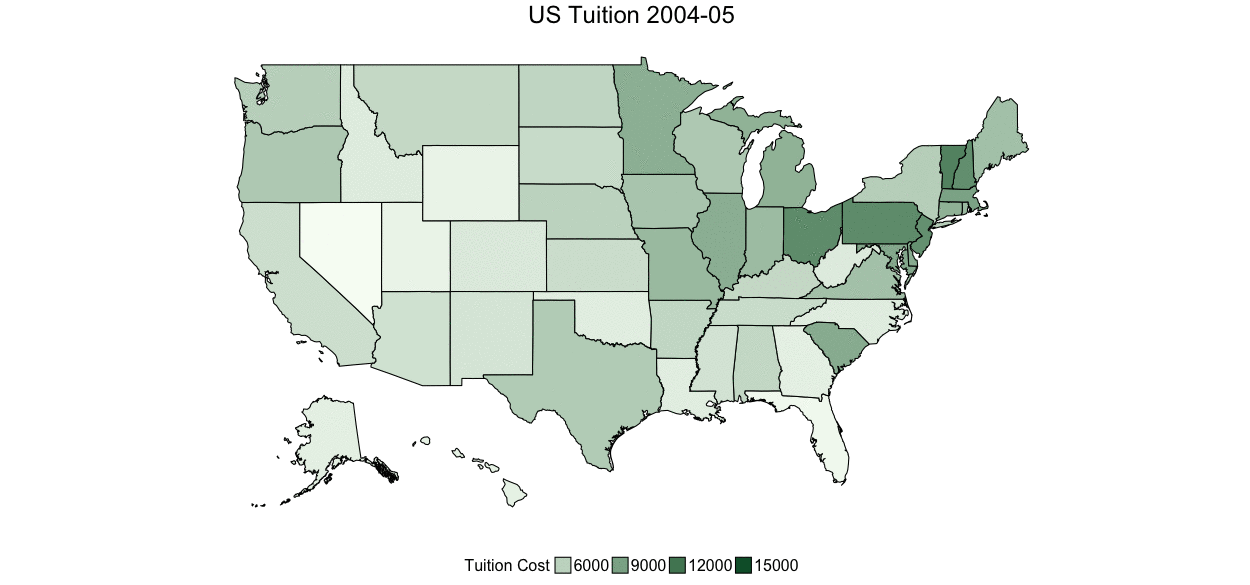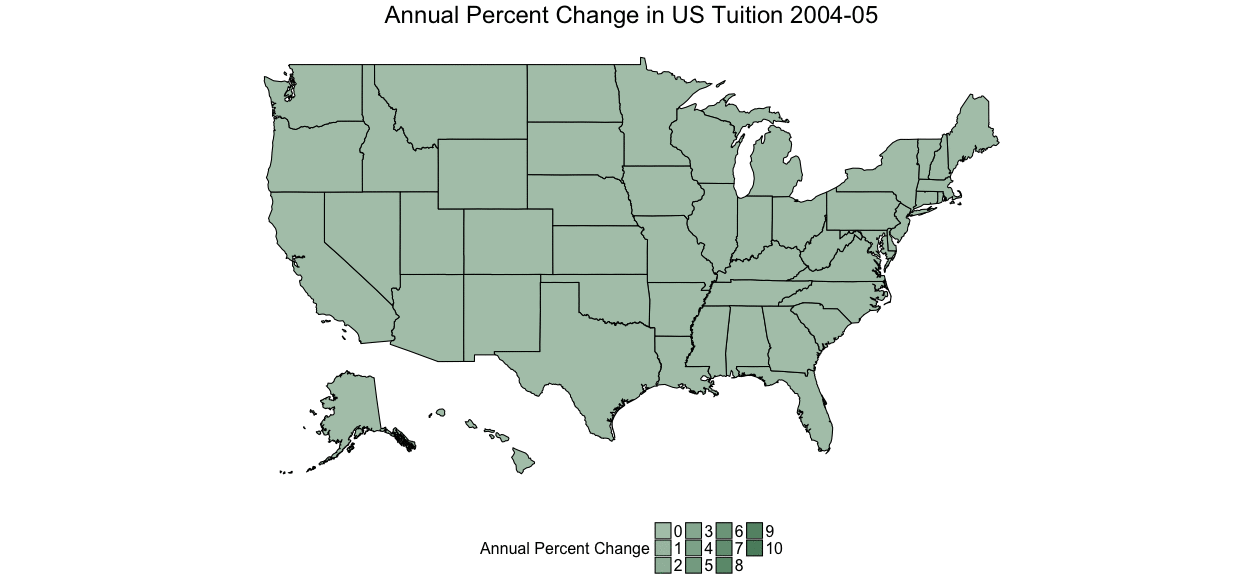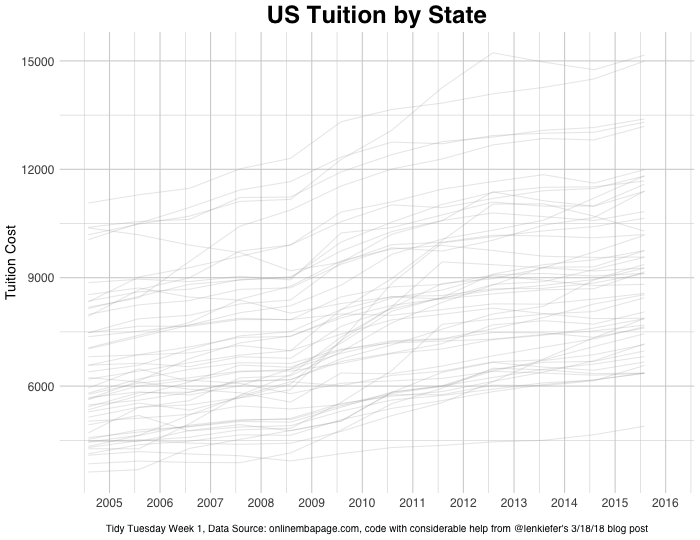Tidy Tuesday is a weekly social data project put on by the R for Data Science Slack learning community (TidyTuesday Repo; R4DS description). The emphasis is on using tidyverse tools to clean and visualize neat data and share it with eachother. I’m not an every week participant but I will share some of my favorite work here and you can see the rest of my visualizations at my github repo linked to this blog post above.
Week 1 deals with US Tuition data and I chose to explore various types of plots
with a focus on the gganimate package. Hope you like it!
Data Sources
Reading in the Data
tuition <- read_xlsx("../data/us_avg_tuition.xlsx")
tuition
## # A tibble: 50 x 13
## State `2004-05` `2005-06` `2006-07` `2007-08` `2008-09` `2009-10`
## <chr> <dbl> <dbl> <dbl> <dbl> <dbl> <dbl>
## 1 Alabama 5683. 5841. 5753. 6008. 6475. 7189.
## 2 Alaska 4328. 4633. 4919. 5070. 5075. 5455.
## 3 Arizona 5138. 5416. 5481. 5682. 6058. 7263.
## 4 Arkansas 5772. 6082. 6232. 6415. 6417. 6627.
## 5 California 5286. 5528. 5335. 5672. 5898. 7259.
## 6 Colorado 4704. 5407. 5596. 6227. 6284. 6948.
## 7 Connecticut 7984. 8249. 8368. 8678. 8721. 9371.
## 8 Delaware 8353. 8611. 8682. 8946. 8995. 9987.
## 9 Florida 3848. 3924. 3888. 3879. 4150. 4783.
## 10 Georgia 4298. 4492. 4584. 4790. 4831. 5550.
## # ... with 40 more rows, and 6 more variables: `2010-11` <dbl>,
## # `2011-12` <dbl>, `2012-13` <dbl>, `2013-14` <dbl>, `2014-15` <dbl>,
## # `2015-16` <dbl>
Looking at this I can tell this is going to be ideal for a spatial plot. So I need some US states! Since it’s through time I think I might also try to animate it with gganimate!
# get case to all lower for id to match
data <- tuition %>%
mutate(id = tolower(State)) %>%
gather(year, cost, -id, -State)
library(gganimate)
library(fiftystater)
# map_id creates the aesthetic mapping to the state name column in your data
p <- ggplot(data, aes(frame = year, map_id = id)) +
# map points to the fifty_states shape data
geom_map(aes(fill = cost), color = "black", map = fifty_states) +
expand_limits(x = fifty_states$long, y = fifty_states$lat) +
coord_map() +
scale_x_continuous(breaks = NULL) +
scale_y_continuous(breaks = NULL) +
labs(x = "", y = "") +
theme(
legend.position = "bottom",
panel.background = element_blank(),
plot.title = element_text(hjust = 0.5, size = 24),
legend.text = element_text(size = 16),
legend.title = element_text(size = 16)
) +
guides(fill = guide_legend(title = "Tuition Cost")) +
ggtitle("US Tuition") +
scale_fill_gradient(low = "#f7fcf5", high = "#005a32")
p
animation::ani.options(interval = .5)
gganimate(p, ani.width = 1250, ani.height = 585, "tuition.gif", title_frame = TRUE)

What’s going on with Illinois?
Could be cool to plot rate of change instead:
library(lubridate)
##
## Attaching package: 'lubridate'
## The following object is masked from 'package:base':
##
## date
rates <- data %>%
mutate(yr_start = mdy(
paste0("08-01-", str_split(year, "[-]") %>% map_chr(., ~ .[1]))
)) %>%
group_by(id) %>%
mutate(diff_pct = c(0, diff(cost)) / cost)
# map_id creates the aesthetic mapping to the state name column in your data
p2 <- ggplot(rates, aes(frame = year, map_id = id)) +
# map points to the fifty_states shape data
geom_map(aes(fill = diff_pct), color = "black", map = fifty_states) +
expand_limits(x = fifty_states$long, y = fifty_states$lat) +
coord_map() +
scale_x_continuous(breaks = NULL) +
scale_y_continuous(breaks = NULL) +
labs(x = "", y = "") +
theme(
legend.position = "bottom",
panel.background = element_blank(),
plot.title = element_text(hjust = 0.5, size = 24),
legend.text = element_text(size = 16),
legend.title = element_text(size = 16)
) +
guides(fill = guide_legend(title = "Annual Percent Change")) +
ggtitle("Annual Percent Change in US Tuition") +
scale_fill_gradient(
low = "white", high = "#005a32",
breaks = c(0, 1, 2, 3, 4, 5, 6, 7, 8, 9, 10)
)
p2
animation::ani.options(interval = 1)
gganimate(p2, ani.width = 1250, ani.height = 585, "rates.gif", title_frame = TRUE)

A good example where an animation does not make the story clearer!
Let’s play with the geofacet library, see if that can clear things up!
library(geofacet)
ts <- rates %>%
ungroup() %>%
select(-id, -diff_pct) %>%
mutate_if(is.character, as.factor) %>%
mutate(ease = "linear", year = as.numeric(year(yr_start) - min(year(yr_start)) + 1))
ggplot(ts, aes(year, cost)) +
geom_line() +
facet_geo(~ State, grid = "us_state_grid3") +
scale_x_continuous(breaks = NULL) +
scale_y_continuous(breaks = NULL) +
labs(
title = "Average US State Tuition Costs 2004-2015",
caption = "Data Source: onlinembapage.com",
x = "Year",
y = "Tuition Cost (%)"
) +
theme(strip.text.x = element_text(size = 6), plot.title = element_text(hjust = .5))

Nice function but the plots are too small for informative axes and the visualization doesn’t quite have the overall punch I would like.
Let’s try making a smooth animated time series plot with a little interpolation help from tweenr!
#### playing with tweenr
## Code adapted from: http://lenkiefer.com/2018/03/18/pipe-tweenr/
library(tweenr)
library(animation)
# filter to just interesting states
ts_fil <- ts %>%
filter(State %in% c("California", "Vermont", "Illinois", "Wyoming",
"Washington", "Florida"))
plot_tween <- tween_elements(ts_fil, time = "year", group = "State",
ease = "ease", nframes = 48)
df_tween <- tween_appear(plot_tween, time = "year", nframes = 48)
# add pause at end of animation
df_tween <- df_tween %>% keep_state(20)
summary(df_tween)
make_plot <- function(i) {
plot_data <-
df_tween %>%
filter(.frame == i, .age > -.5)
p <- plot_data %>%
ggplot() +
geom_line(aes(x = yr_start, y = cost, color = .group), size = 1.3) +
geom_point(
data = . %>% filter(yr_start == max(yr_start)),
mapping = aes(x = yr_start, y = cost, color = .group),
size = 3, stroke = 1.5
) +
geom_point(
data = . %>% filter(yr_start == max(yr_start)),
mapping = aes(x = yr_start, y = cost, color = .group), size = 2
) +
geom_text(
data = . %>% filter(yr_start == max(yr_start)),
mapping = aes(
x = yr_start, y = cost, label = .group,
color = .group
), nudge_x = 7, hjust = -0.4, fontface = "bold"
) +
geom_line(data = ts, aes(x = yr_start, y = cost, group = State),
alpha = 0.25, color = "darkgray") +
theme_minimal(base_family = "sans") +
scale_color_manual(values = c("#fec44f", "#253494", "#f46d43",
"#1a9850", "#542788", "#993404")) +
scale_x_date(
limits = c(as.Date("2004-08-01"), as.Date("2016-01-01")),
date_breaks = "1 year", date_labels = "%Y"
) +
theme(
legend.position = "none",
plot.title = element_text(face = "bold", size = 24, hjust = .5),
plot.caption = element_text(hjust = .5, size = 10),
axis.title.y = element_text(size = 14),
axis.text.x = element_text(size = 12),
axis.text.y = element_text(size = 12),
panel.grid.major.x = element_line(color = "lightgray"),
panel.grid.minor.x = element_line(color = "lightgray"),
panel.grid.major.y = element_line(color = "lightgray"),
panel.grid.minor.y = element_line(color = "lightgray")
) +
labs(
x = "", y = "Tuition Cost",
title = "US Tuition by State",
caption = "Tidy Tuesday Week 1, Data Source: onlinembapage.com, code with considerable help from @lenkiefer's 3/18/18 blog post"
)
return(p)
}
oopt <- ani.options(interval = 1 / 10)
saveGIF({
for (i in 1:max(df_tween$.frame)) {
g <- make_plot(i)
print(g)
print(paste(i, "out of", max(df_tween$.frame)))
ani.pause()
}
}, movie.name = "tuition2.gif", ani.width = 700, ani.height = 540)

In order to promote readibility I had to select a subset of states but still pretty cool! Especially given my best attempt to match school colors! Now we can really see tuition is rising steadily! I wonder how it compares to inflation… a visualization for another time perhaps!